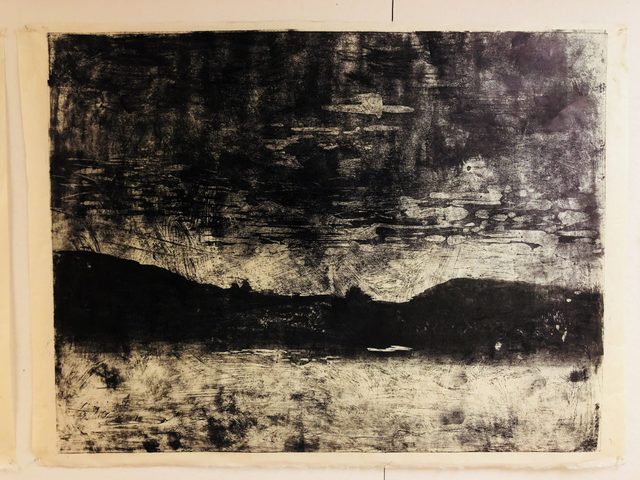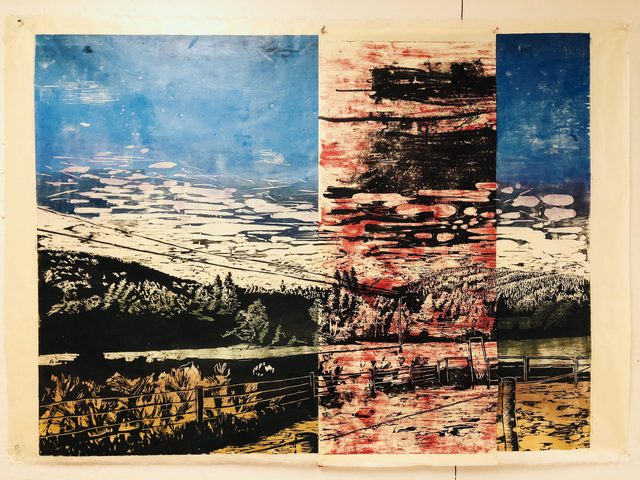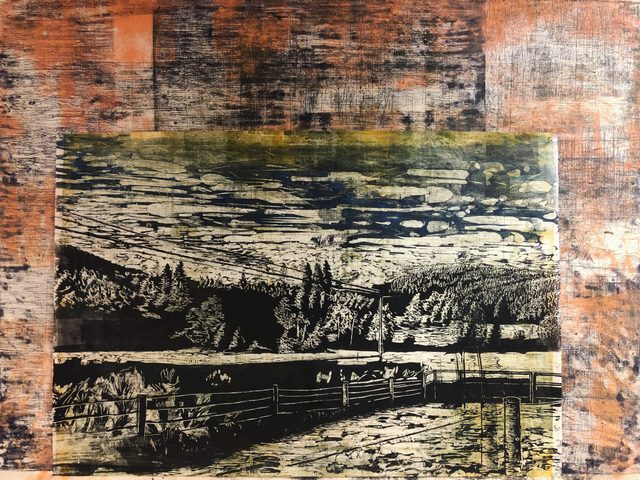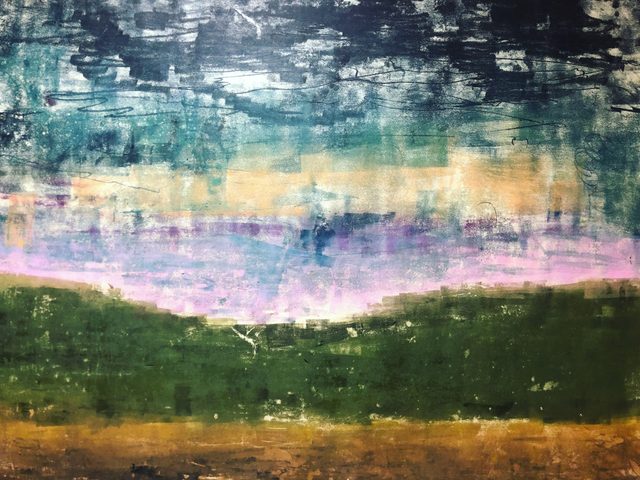Comps Insider: Levi Atkinson ’19
Levi Atkinson ’19, a studio art and art history double major from Albany, Oregon, tells us about his senior capstone experience, or “Comps,” in support of both degrees.
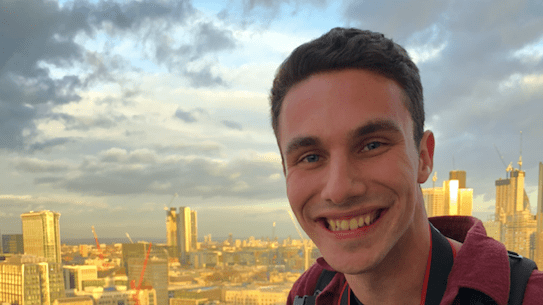
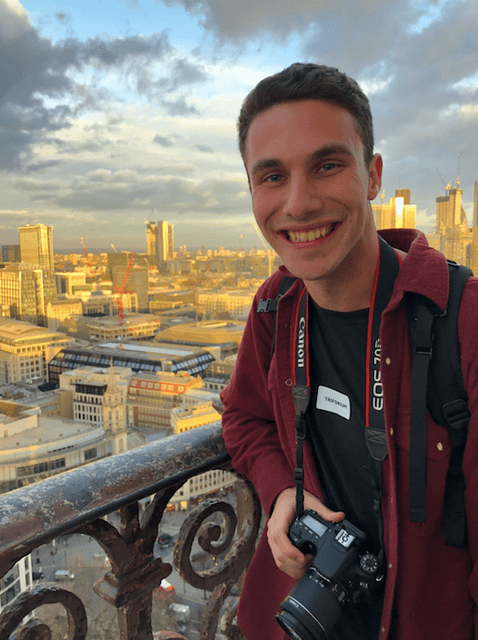
What is the title of your Comps?
The title of my studio art Comps is: Untitled (44.623731, -122.72340)
The title of my art history Comps is: Revival, Renaissance, and Revolution: Atelier 17 and Mid-Century Printmaking in America
What is your Comps topic?
For my studio art Comps I created a portfolio of relief monoprints based on a singular image. I focused on investigating how our interactions with landscapes and connections to these landscapes shape our memory of place. My Comps articulates the relationship between temporality, memory, and experience. Each print forms the landscape differently based on a variety of varying elements including mark, texture, opacity, composition, color, etc. Interested in complicating the notion of the landscape through the manipulation of the image, there is no singular moment but rather a collection of moments in no linear narrative.
The image I worked from is a picture I took this past summer when I was at my grandparents’ farm/backyard in Oregon. The image was taken at the exact location coordinates of 44.623731, -122.723401. The coordinates are important because a juxtaposition is created with the multiplicity of the portfolio. There exists a paradox between the specificity of the coordinate and the ambiguity of the space through the varying images. Furthermore, this space has been a place that I have constantly come back to almost annually.
Growing up and living in a variety of places, the ideas of displacement and the temporality of those past spaces have been very influential in forming how I see the world. In contrast, this space has been a constant for me. This natural space isn’t somewhere I would call ‘home,’ but is rather a natural space that I have been able to continually revisit throughout my life. When I go back, each experience is different both in terms of its aesthetic makeup and my personal encounter. This further reinforces the paradox of the landscape being a constant while also ever changing in itself.
Through my Comps I hope for the viewer to not only see the relationship between place and people, but also think about how the natural spaces, textures, color, shapes, etc. affect the ways in which we emotionally and visually understand the natural world.
My art history Comps focused on exploring the critical and experimental American printmaking movement during the 1950s and 1960s that stemmed out of S.W. Hayter’s print studio, Atelier 17, in New York. Within this printmaking movement there was a revival of old printmaking methods, revolution against historical notions of printmaking as a medium, and innovation with process in a contemporary art context.
My research looked at the theories of Atelier 17 and put them in conversation with other emerging theories of art such as that of the newly developing American Action Painters and formalist art theory. Atelier 17 focused on developing and teaching printmaking from an experimental and learning through process style rather than the more traditional and pedagogical model that historically existed within printmaking shops. Many artists from all different artistic backgrounds studied printmaking in Atelier 17 and took the medium in variety of concept and aesthetic directions thus expanding and reviving the medium in a contemporary context.
Additionally, I looked at five artists (Leonard Baskin, Anne Ryan, Worden Day, Misch Kohn, and Gabor Peterdi) and their work who were connected to Atelier 17 and produced both critical and unprecedented work within printmaking.
Why did you choose your Comps topics?
For my studio art Comps, early on in the term I decided I wanted to work with color relief printmaking on a quite large scale. Additionally, I really wanted to experiment with what I could do with relief printmaking. In terms of content, landscapes have always been a big part of my life and a big part of my life and my work, so I chose to explore the landscape and one that held some meaning to me both aesthetically and personally.
For my art history Comps, I was interested in exploring a topic that was totally foreign to me. I had learned printmaking before doing my Comps, so I knew some basics around the process, but I had never really formally studied printmaking in an art history class. Printmaking to me is a unique medium with extremely historical roots. I randomly learned about this print movement that often gets overshadowed in the larger context of art history while skimming through a random library book focused on printmaking in America. I was immediate intrigued by the formal and experimental aspects of the work that so clearly stood out. With that discovery came many more questions which turned into my art history Comps.
What was the most interesting article or piece of information that you found while researching your Comps?
With my studio art Comps, something the department and my Comps advisor strongly encouraged during the Comps process, was spending time exploring other artists who explore similar concepts and processes. By discovering a variety of artists and learning about their material and conceptual approach to their work, I was better able to understand what I wanted to explore and do within my work.
Eva Pietzerker is a contemporary printmaker who creates woodcut prints based on landscapes. I looked into her methods for creating natural spaces via relief prints. Her work deals with the idea of going beyond simple representations of landscapes. She explores the mystery of the transcendental nature of the landscape through her composition, color, and mark. It was cool to discover established artists who were exploring similar processes and concepts as me. I was able to learn and gain inspiration from artists while taking similar concepts in my own artists direction, like Munch and Pietzerker, strive to gain a broader and richer understanding of the landscape through the relief printmaking process.
Last summer, prior to doing art history Comps, I interned at the Art Institute of Chicago. While there I was able to make appointments with their print study room. Their print department has many works by the artists I was researching for my Comps, so I was able to request to see the works. Having them bring the works out unframed allowed me to look at and analyze the prints up close rather than just finding images of the works online which was pretty cool.
What was your Comps process like?
My Comps process and timeline for both projects were actually quite different because, although I did both Comps fall term, I began doing research for my art history Comps the summer leading up to fall term and with my studio art Comps I didn’t really figure out what I was doing until the later part of second week of fall term. My studio process was experimental and open ended in terms of how the final prints evolved. I constantly worked the prints by cropping the image, cutting up prints and layering prints in order to think about how the images is framed and how the process reflects the layering and meshing of memories. I also created a variety of additional blocks to print color and textures onto the prints.
With my art history Comps I wrote a proposal late spring term during my art history Junior Seminar. Having access to the Art Institute of Chicago’s library, I was able to spend my free time researching and finding potential sources for my Comps project. Fall term was spent doing research and writing the 35-page paper. The research and the writing overlapped in time so I would write while still discovering new sources and reading more about my topic. I had mini-drafts due throughout the term and a final draft due at the end of fall term. I worked on revising my Comps over winter break as I went abroad winter term.
Why do you think it was valuable for you to do your Comps projects?
With both Comps I was able to really explore concepts, processes, and topics in depth. Compared to other assignments or projects I’ve done at Carleton, you only have a few weeks at most to complete them. Having a full ten weeks to work, research, and write really helped give me a new ability to work on bigger and longer projects.
Will you expand on your Comps in any way?
I don’t think I will expand anymore with either Comps during my time at Carleton, but I would like to continue exploring these topics within both Comps outside of Carleton.
For my studio art Comps, I would like to continue working with monoprints as a process and continue working with topics revolving around the landscape.
For my art history Comps, I will be giving a talk on my topic later in spring term. Additionally, my Csomps leave off talking about the beginning of the revival of lithography in the late 1960s. I didn’t have the space in my Comps to research this other later movement. I would like to further explore printmaking during this period and look at printmaking post-1960s and how it continually progressed as a medium.
